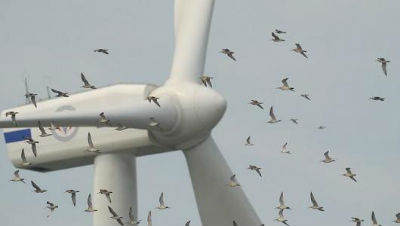A new map developed by the U.S. Fish and Wildlife Service and recently online would appear to put a damper on future development of land-based wind energy projects in eastern North Carolina.
But Kathy Matthews, a service biologist who worked on the map, and Charles “Pete” Peterson said that shouldn’t be the case. Peterson is a professor and researcher at the University of North Carolina’s Institute of Marine Sciences in Morehead City. He helped lead a state-funded team several years ago that developed a similar tool for offshore wind.
Supporter Spotlight
“Clearly, there are places where, for a variety of reasons, including the presence of large numbers of birds and other wildlife, these projects should not be,” Peterson said. “But there are many other sites that are suitable. There might not be quite as much wind, but there is enough. There is a lot of flat, farmland in good wind areas with less potential for major impacts on birds. What this kind of planning does is give potential developers information, upfront, about where they probably should concentrate their efforts.”
 The new maps from the U.S. Fish and Wildlife Service are intended to minimize wind turbines’ effects on birds and other wildlife. |
The concept, he said, saves potential wind farm developers time and money and means that efforts those developers undertake are more likely to get the necessary approvals.
The Fish and Wild Service map focuses on potential interactions between migratory birds and waterfowl in eastern North Carolina, where energy companies have expressed the most interest.
According to Matthews, the areas of greatest concern indicated on the map include corridors around the larger rivers on the outer coastal plain and near the existing nine wildlife refuges, such as Alligator River and Pocosin Lakes. Map areas in red are the areas of highest concern; green signifies low-risk areas; and moderate-risk areas are yellow. Areas in black are federally managed, and areas in orange hatch are conservation areas managed by the state, the federal government or others, such as private environmental groups.
It was a pilot project from the service’s regional office in Atlanta, but much of the work was done by Matthews and others out of the state office in Raleigh.
Supporter Spotlight
“The idea wasn’t to make it difficult for wind projects in the state, it was to identify areas where there are problems so those who are interested in projects know the best areas to concentrate their efforts,” she said. “So far, mostly what we’ve heard has been positive. The companies that we have worked with seem to appreciate knowing the areas where we have major concerns.”
The red areas on the map were primarily designated because they provide habitat for large numbers of migratory water birds. Another instant red flag was the presence of a known nest of an eagle or other endangered species.
“None of this means it’s impossible to develop wind energy in any of these areas,” Matthews said. “This just identifies the areas in which we are likely to provide more scrutiny.”
The service, she added, does not actually even have regulatory authority, but works with the companies to reduce potential impacts.
“If it’s a red area, we might ask them not to put a facility there,” she said. “If it’s a yellow area, they can expect a higher level of scrutiny than in a green area, but what we would probably do is work with them to figure out ways to modify the layout of the turbines or modify the operation of the turbines to minimize impacts.”
The concerns are not exclusively about the much-discussed collisions between birds and blades; wildlife biologists are also greatly concerned about disturbing the birds’ nesting areas and their food sources. It doesn’t do much good to protect the birds if they can’t eat and reproduce successfully.
 Pete Peterson |
Matthews said there has been talk of expanding the pilot project to include other states in the service’s southeast region, but she doesn’t know whether adequate resources will be available anytime soon. It’s time-consuming and labor-intensive work, she said, and the Raleigh office was fortunate to have a cartographer on staff.
Peterson has long been involved in marine research and has supported of wind energy development for quite some time.
Just before the turn of the decade, the state legislature adopted rules to let UNC contract with a third party, which turned out to be Duke Energy, to build a pilot wind-energy project in state waters. But the legislature also asked UNC to develop a report on potential sites. In 2009, Peterson and other members of a team chosen to do that turned in a 378-page report that looked at everything from birds to bats, fisheries, the impacts of buried cables, interference with military flight paths and legal issues.
The 2009 report concluded that North Carolina has the most potential offshore wind energy on the East Coast. Wind-energy entrepreneurs and companies need good information to avoid potential conflicts with wildlife and natural resource, Peterson said. The UNC study provides that type of detail for coastal and offshore waters, he said, and the Fish and Wildlife Service does the same for land-based projects.
“There have been projects proposed in areas (in North Carolina) that were obviously very problematic,” he said.
For example, Chicago-based Invenergy has at least temporarily abandoned its plan for the 49-turbine Pantego project in Beaufort County because of a potential threat to bald eagles and conflicts Seymour Johnson Air Force Base near Goldsboro over jet fighter training.
Another proposed Invenergy project, called Hales Lake Wind Farm, in Currituck and Camden counties, has been facing similar issues. The Navy is worried about the turbines’ effects on its radar system in Chesapeake, Va., and the Coast Guard is concerned about the turbines’ potential impacts at it’s station in Elizabeth City.
Obviously, Peterson said, military concerns are not the same as the bird and habitat concerns outlined on the Fish and Wildlife Service map. But the concept is the same: It’s better for everyone involved to have as much information as possible, as early in the process as possible.
“Doing these kinds of things so people don’t waste effort and time and money when there are obviously potential conflicts is very sensible,” he said.
Matthews said it’s important to realize that while many wind projects appear to have at least temporarily stalled, there is still great interest in developing the major resource available in North Carolina on land and in offshore waters. The federal government, after much discussion, recently extended tax credits for renewable energy development, which should continue to make projects economically viable.
Nationwide, according to the American Wind Energy Association, wind energy grew 28 percent in America in 2012, setting a new installation record and confirming its status as a mainstream energy source.
According to the association’s U.S. Wind Industry Annual Market Report for 2012, released April 11, it was the best year ever.
“The U.S. industry topped all energy sources, with 42 percent of all new U.S. electric generating capacity,” a news release states. “Over 6,700 new wind turbines were erected, which produce enough electricity to power the equivalent of 3.5 million homes. Overall, America finished the year with 45,100 wind turbines that can power 15.2 million homes.
The bumper crop of wind energy benefited the U.S. economy across all 50 states, through $25 billion in private investment in new U.S. wind farms, tens of millions of dollars paid to landowners and local communities in lease payments and property taxes, and billions in projected savings for electricity consumers.







